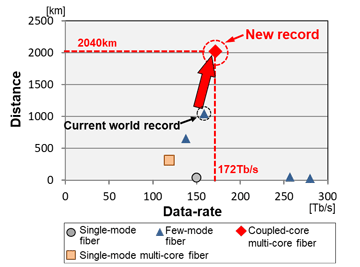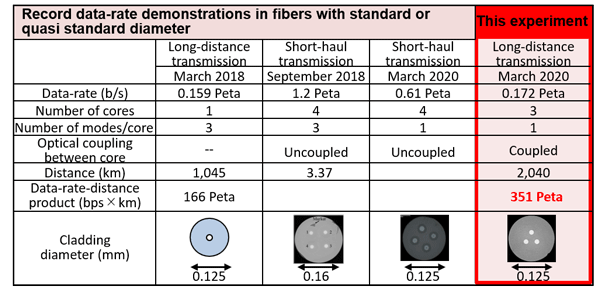- A world record for high-capacity, long-haul transmission in standard diameter optical fibers was achieved in coupled-3-core multi-core fiber with characteristics similar to multi-mode fibers.
- The signal processing complexity is significantly reduced compared to multi-mode fibers.
- The fiber type is promising for early adoption in backbone high-capacity transmission systems as it can be cabled with the same technology.
Background

Achievements
NICT constructed a large-capacity, long-distance transmission system based on the results of Bell Labs’ long-distance transmission demonstration experiment using the suppressed modal dispersion characteristics of a coupled-core multi-core fiber. 359 wavelength channels were modulated by 16QAM signals, and a total data-rate of 172 terabits per second was successfully transmitted over 2,040 km. Converted to the product of transmission capacity and distance, which is a general indicator of transmission capacity, 351 petabit per second x km was achieved, which is more than twice the current world record. When using coupled-core multi-core fibers for transmission, it is necessary to eliminate the interference between optical signals between cores by signal processing (MIMO processing) on the receiving side. To date, transmission over coupled-core multi-core fibers has been performed only in a limited signal band (less than 5 nanometers in wavelength range), and it was unclear whether it is possible to achieve both long-distance transmission characteristics and large-capacity transmission in coupled-core multi-core fibers. In this experiment, using a standard outside diameter optical fiber, we succeeded in transmitting 17 times the backbone communication capacity of Japan over a distance of 2,040 km. The standard outside diameter optical fiber is compatible with conventional fiber cables, increasing prospects for early commercialization of large-capacity backbone communication systems.
Future Prospects
We will work on research and development of future optical communication infrastructure technology that can smoothly accommodate traffic such as 5G-based services and international communications via submarine cables. The paper on the results of this experiment was published at the 43rd International Conference on Optical Fiber Communication (OFC 2020, March 8 (Sun) – March 12 (Thu)), one of the largest international conferences on optical fiber communication held in San Diego, USA. It was highly evaluated and was presented in the Post Deadline session, known for release of latest important research achievements, and published on Thursday, March 12 2020.References
International Conference: 43rd International Conference on Optical Fiber Communications (OFC 2020) Post Deadline PaperTitle: 172 Tb/s C+L Band Transmission over 2,040 km Strongly Coupled 3-Core Fiber Authors: Georg Rademacher, Ruben S. Luís, Benjamin J. Puttnam, Roland Ryf, Sjoerd v. d. Heide, Tobias A. Eriksson, Nicolas K. Fontaine, Haoshuo Chen, René-Jean Essiambre, Yoshinari Awaji, Hideaki Furukawa, and Naoya Wada Source :
https://www.nict.go.jp/en/press/2020/04/02-1.html